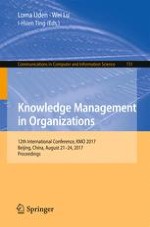This book contains the refereed proceedings of the 12th International Conference on Knowledge Management in Organizations, KMO 2017, held in Beijing, China, in August 2017. The theme of the conference was "Emerging Technology and Knowledge Management in Organizations."
The 45 contributions accepted for KMO 2017 were selected from 112 submissions and are organized in topical sections on: Knowledge Management Models and Behaviour Studies; Knowledge Sharing; Knowledge Transfer and Learning; Knowledge and Service Innovation; Knowledge and Organization; Information Systems Research; Value Chain and Supply Chain; Knowledge Re-presentation and Reasoning; Data Mining and Intelligent Science; Big Data Management; Internet of Things and Network.
